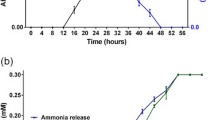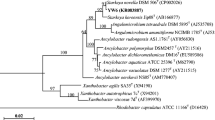Abstract
Burkholderia sp. RKJ 800 utilized 4-chloro-2-aminophenol (4C2AP) as the sole carbon and energy source and degraded it with release of chloride and ammonium ions. The metabolic pathway of degradation of 4C2AP was studied and a novel intermediate, 4-chlorocatechol was identified as a major degradation product of 4C2AP using high-performance liquid chromatography and gas chromatography–mass spectrometry. Enzyme activities for 4C2AP-deaminase and 4-chlorocatechol-1,2-dioxygenase were detected in the crude extracts of the 4C2AP-induced cells of strain RKJ 800. The activity of the 4C2AP-deaminase confirmed the formation of 4-chlorocatechol from 4C2AP and the 4-chlorocatechol-1,2-dioxygenase activity suggested the cleavage of 4-chlorocatechol into 3-chloro-cis,cis-muconate. On the basis of the identified metabolites, we have proposed a novel degradation pathway of 4C2AP for Burkholderia sp. RKJ 800. Furthermore, the potential of Burkholderia sp. RKJ 800 to degrade 4C2AP in soil was also investigated using microcosm studies under laboratory conditions. The results of microcosm studies conclude that Burkholderia sp. RKJ 800 was able to degrade 4C2AP in soil and may be used to remediate 4C2AP-contaminated site. This is the first report of (1) the formation of 4-chlorocatechol and 3-chloro-cis,cis-muconate in the degradation pathway of 4C2AP and (2) bioremediation of 4C2AP by any bacterium.




Similar content being viewed by others
References
Arora PK (2012) Decolourization of 4-chloro-2-nitrophenol by a soil bacterium, Bacillus subtilis RKJ 700. PLOS ONE 7(12):e52012
Arora PK, Jain RK (2012a) Biotransformation of 4-chloro-2-nitrophenol into 5-chloro-2-methylbenzoxazole by a marine Bacillus sp. strain MW-1. Biodegradation 23:325–331
Arora PK, Jain RK (2012b) Metabolism of 2-chloro-4-nitrophenol in a Gram negative bacterium, Burkholderia sp. RKJ 800. PLOS ONE 7(6):e38676
Arora PK, Sasikala C, Ramana CV (2012a) Degradation of chlorinated nitroaromatic compounds. Appl Microbiol Biotechnol 93:2265–2277
Arora PK, Sharma A, Mehta R, Shenoy BD, Srivastava A, Singh VP (2012b) Metabolism of 4-chloro-2-nitrophenol in a Gram-positive bacterium, Exiguobacterium sp. PMA. Microb Cell Fact 11:150
Beunink J, Rehm HJ (1990) Coupled reductive and oxidative degradation of 4-chloro-2-nitrophenol by a co-immobilized mixed culture system. Appl Microbiol Biotechnol 34:108–115
Cámara B, Nikodem P, Bielecki P, Bobadilla R, Junca H, Pieper DH (2009) Characterization of a gene cluster involved in 4-chlorocatechol degradation by Pseudomonas reinekei MT1. J Bacteriol 191:4905–4915
Dorn E, Hellwig M, Reineke W, Knackmuss HJ (1974) Isolation and characterization of a 3-chlorobenzoate degrading pseudomonad. Arch Microbiol 99:61–70
Hollender J, Hopp J, Dott W (1997) Degradation of 4-chlorophenol via the meta cleavage pathway by Comamonas testosteroni JH5. Appl Environ Microbiol 63:4567–4572
Lendenmann U, Spain JC (1996) 2-Aminophenol 1,6-dioxygenase: a novel aromatic ring cleavage enzyme purified from Pseudomonas pseudoalcaligenes JS45. J Bacteriol 178:6227–6232
Nikodem P, Hecht V, Schlomann M, Pieper DH (2003) New bacterial pathway for 4- and 5-chlorosalicylate degradation via 4-chlorocatechol and maleylacetate in Pseudomonas sp. strain MT1. J Bacteriol 185:6790–800
Pantoja PD, Ledger T, Pieper DH, González B (2003) Efficient turnover of chlorocatechols is essential for growth of Ralstonia eutropha JMP134(pJP4) in 3-chlorobenzoic acid. J Bacteriol 185:1534–1542
Park HS, Lim SJ, Chang YK, Linvingston AG, Kim HS (1999) Degradation of chloronitrobenzenes by a coculture of Pseudomonas putida and a Rhodococcus sp. Appl Environ Microbiol 65:1083–1091
Weisshaar MP, Franklin FC, Reineke W (1987) Molecular cloning and expression of the 3-chlorobenzoate-degrading genes from Pseudomonas sp. strain B13. J Bacteriol 169:394–402
Acknowledgment
This work was financially supported by the University Grants Commission, New Delhi, under the scheme of Dr. D.S. Kothari Post-Doctoral Fellowship.
Author information
Authors and Affiliations
Corresponding author
Additional information
Responsible editor: Gerald Thouand
Rights and permissions
About this article
Cite this article
Arora, P.K., Srivastava, A. & Singh, V.P. Novel degradation pathway of 4-chloro-2-aminophenol via 4-chlorocatechol in Burkholderia sp. RKJ 800. Environ Sci Pollut Res 21, 2298–2304 (2014). https://doi.org/10.1007/s11356-013-2167-y
Received:
Accepted:
Published:
Issue Date:
DOI: https://doi.org/10.1007/s11356-013-2167-y




